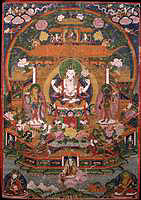
|
Bodhisattva Avalokiteshvara (painting no. 80)
|

View Larger Image |
||||||||||||||
|
[80] Avalokiteshvara (Tibetan: chen re zi, English: the All Seeing Lord) in the pure realm of Potala. "As the nature of all buddhas, Avalokiteshvara, in colour like stainless conch and crystal, very resplendent, smiling, peaceful and radiant. With four hands the first are folded at the heart, the lower hold a crystal mala and jewelled lotus, two beautiful feet seated in vajra posture, adorned with many attractive silks and jewels, beautified with dark blue hair in tufts [some] loose. On the crown of the head, the wisdom of all buddhas, is the Lord, source of all refuge gathered as one, in essence the Guru in the aspect of Amitabha, in the manner of the Lord of the Family, seated happily." (Ngorchen Konchog Lhundrup 1497-1557). Above a moon disc, multi-coloured lotus and lion supported throne and backrest Avalokiteshvara sits in the Palace garden in his pure land of Potala from which the home of the Dalai lamas is named. Standing to the left on a pink lotus and moon disc is the bodhisattva Manjushri, orange in colour, holding in the right hand the stem of a lotus to the heart, blossoming at the ear and supporting the wisdom sword. Standing to the right is Vajrapani, dark blue in colour, holding in the left hand the stem of a lotus to the heart, blossoming at the ear and supporting a gold upright vajra. In the front courtyard to the left of the lotus pond is the god Indra (Shakra), white, holding a conch shell. Behind that is a green horse-headed Kimnara holding a red gem, and a naga deity with the lower body in the shape of a dark green snake. In the foreground is a god of the asura realm holding a jewel excreting mongoose. To the right of the lotus pond is the god Brahma, orange in colour, with four heads, holding the wheel of cosmic law. Behind, a pink garuda bird, with green wings, holds a red wishing jewel. Behind that is a yaksha daemon holding a banner. In the foreground is a gandharva (celestial musician), white in colour. The palace is ornate and decorative with an outer wall and four doors (3 visible). At each door stands an emanation of Avalokiteshvara. Surrounded by water the pureland is located on an island in the southern ocean. Seated in the upper level of the palace are the three Long-life deities. In the middle is Amitayus, red, with the hands folded in the lap supporting a long-life vase. To the left is the goddess Ushnishavijaya, white with three faces and eight hands. To the right is White Tara with one face and two hands in supreme generosity and holding a white lotus. The entire Potala pureland is filled with lotus blossoms and surrounded with rainbow light forming a sphere. In the clouds above gods pay homage to Avalokiteshvara while saints fly freely in the air. At the central gate, travelling on a rainbow path, a monk and a nobleman seek admission to the pureland. At the bottom left is Guru Padmasambhava (8th century) holding a vajra in the right hand and a skullcup and vase in the left, wearing elaborate robes and a lotus hat. On the right is yellow Jambhala holding a bijapuraka fruit in the right hand and a mongoose in the left. Avalokiteshvara is the patron bodhisattva of Tibet and is practiced by all traditions. There are numerous Sarma lineages and different forms of practice which span all four tantric classifications as well as uncounted Kama and Terma (treasure) traditions from the Nyingmapa School. J.Watt 7-98
|
|||||||||||||||
Photographed Image Copyright © 1998 Shelley & Donald Rubin Foundation
|
|
| |
Next Image |